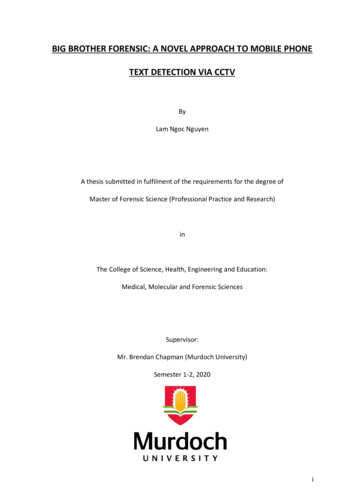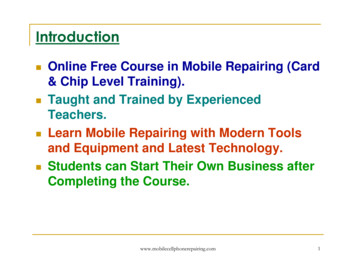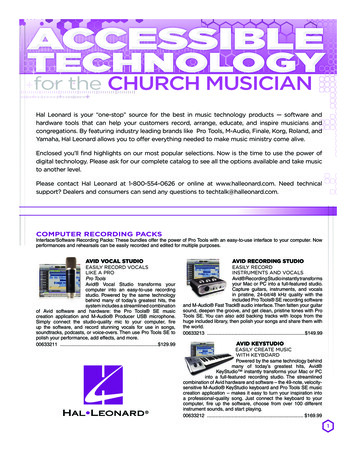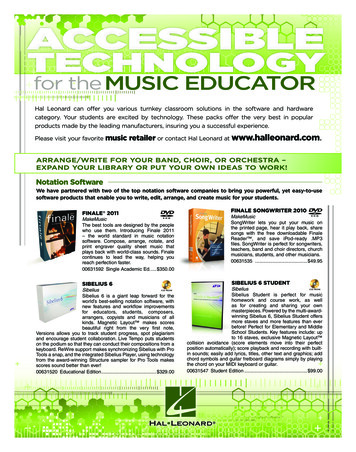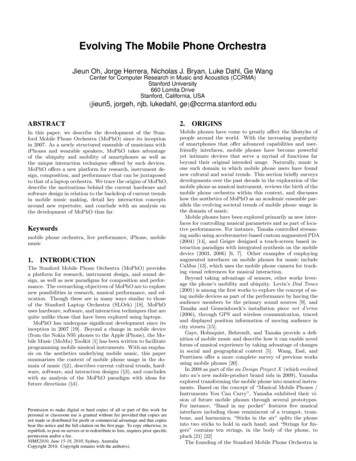
Transcription
Evolving The Mobile Phone OrchestraJieun Oh, Jorge Herrera, Nicholas J. Bryan, Luke Dahl, Ge WangCenter for Computer Research in Music and Acoustics (CCRMA)Stanford University660 Lomita DriveStanford, California, USA{jieun5,jorgeh, njb, lukedahl, ge}@ccrma.stanford.eduABSTRACT2.In this paper, we describe the development of the Stanford Mobile Phone Orchestra (MoPhO) since its inceptionin 2007. As a newly structured ensemble of musicians withiPhones and wearable speakers, MoPhO takes advantageof the ubiquity and mobility of smartphones as well asthe unique interaction techniques offered by such devices.MoPhO offers a new platform for research, instrument design, composition, and performance that can be juxtaposedto that of a laptop orchestra. We trace the origins of MoPhO,describe the motivations behind the current hardware andsoftware design in relation to the backdrop of current trendsin mobile music making, detail key interaction conceptsaround new repertoire, and conclude with an analysis onthe development of MoPhO thus far.Mobile phones have come to greatly affect the lifestyles ofpeople around the world. With the increasing popularityof smartphones that offer advanced capabilities and userfriendly interfaces, mobile phones have become powerfulyet intimate devices that serve a myriad of functions farbeyond their original intended usage. Naturally, music isone such domain in which mobile phone users have foundnew cultural and social trends. This section briefly surveysdevelopments over the past decade in the exploration of themobile phone as musical instrument, reviews the birth of themobile phone orchestra within this context, and discusseshow the aesthetics of MoPhO as an academic ensemble parallels the evolving societal trends of mobile phone usage inthe domain of music.Mobile phones have been explored primarily as new interfaces for controlling musical parameters and as part of locative performances. For instance, Tanaka controlled streaming audio using accelerometer-based custom augmented PDA(2004) [14], and Geiger designed a touch-screen based interaction paradigm with integrated synthesis on the mobiledevice (2003, 2006) [6, 7]. Other examples of employingaugmented interfaces on mobile phones for music includeCaMus [13], which uses the mobile phone camera for tracking visual references for musical interaction.Beyond taking advantage of sensors, other works leverage the phone’s mobility and ubiquity. Levin’s Dial Tones(2001) is among the first works to explore the concept of using mobile devices as part of the performance by having theaudience members be the primary sound sources [9], andTanaka and Gemeinboeck’s installation piece net d’erive(2006), through GPS and wireless communication, tracedand displayed position information of moving audience incity streets [15].Gaye, Holmquist, Behrendt, and Tanaka provide a definition of mobile music and describe how it can enable novelforms of musical experience by taking advantage of changesin social and geographical context [5]. Wang, Essl, andPenttinen offer a more complete survey of previous worksusing mobile phones [20].In 2008 as part of the au Design Project X (which evolvedinto au’s new mobile-product brand iida in 2009), Yamahaexplored transforming the mobile phone into musical instruments. Based on the concept of “Musical Mobile Phones /Instruments You Can Carry”, Yamaha exhibited their vision of future mobile phones through several prototypes.For instance, “Band in my pocket” features five musicalinterfaces including those reminiscent of a trumpet, trombone, and harmonica; “Sticks in the air” splits the phoneinto two sticks to hold in each hand; and “Strings for fingers” contains ten strings, in the body of the phone, topluck.[21] [22]The founding of the Stanford Mobile Phone Orchestra inKeywordsmobile phone orchestra, live performance, iPhone, mobilemusic1.INTRODUCTIONThe Stanford Mobile Phone Orchestra (MoPhO) providesa platform for research, instrument design, and sound design, as well as new paradigms for composition and performance. The overarching objectives of MoPhO are to explorenew possibilities in research, musical performance, and education. Though these are in many ways similar to thoseof the Stanford Laptop Orchestra (SLOrk) [18], MoPhOuses hardware, software, and interaction techniques that arequite unlike those that have been explored using laptops.MoPhO has undergone significant development since itsinception in 2007 [19]. Beyond a change in mobile device(from the Nokia N95 phones to the Apple iPhone), the Mobile Music (MoMu) Toolkit [1] has been written to facilitateprogramming mobile musical instruments. With an emphasis on the aesthetics underlying mobile music, this papersummarizes the context of mobile phone usage in the domain of music (§2), describes current cultural trends, hardware, software, and interaction designs (§3), and concludeswith an analysis of the MoPhO paradigm with ideas forfuture directions (§4).Permission to make digital or hard copies of all or part of this work forpersonal or classroom use is granted without fee provided that copies arenot made or distributed for profit or commercial advantage and that copiesbear this notice and the full citation on the first page. To copy otherwise, torepublish, to post on servers or to redistribute to lists, requires prior specificpermission and/or a fee.NIME2010, June 15-18, 2010, Sydney, AustraliaCopyright 2010, Copyright remains with the author(s).ORIGINS
Figure 1: The Stanford Mobile Phone Orchestra2007, as a repertoire-based ensemble using mobile phonesas the primary instrument, was intended to further theseconcepts as well as explore new possibilities. The increasing computational power of mobile phones has allowed forsound synthesis without the aid of an external computer.In fact, mobile phones have come to be regarded more as“small computers” with PC-like functionality than as simply phones with augmented features. For the purpose ofmusic making, one may even regard the phone as beingsuperior to computers, offering light-weight yet expressiveinteractive techniques made possible by its various on-boardsensors.The aesthetics behind MoPhO design considerations embrace the new culture of “mobile music” enjoyed by mobilephone users. MoPhO aims to improve the process of instrument development and performance experience — not onlyfor students and researchers in computer music, but also forthe broader population — thereby exploring new technological and artistic opportunities for music making. The nextsection describes the present status of the ensemble againstthe social backdrop of increasing mobile application usage.3.PRESENTThe proliferation of smartphones and other mobile platforms — such as Nintendo DS or the PSP — along withtheir corresponding SDKs and APIs have encouraged developers to create applications for these devices. The sheernumber of mobile instruments that have been developedrecently illustrates the increasing interest in mobile musicapplications. These applications cover a wide range of musical interactions and sounds, from basic sample-based andtouch-triggered instruments[2] to more advanced accelerom-eter and multitouch based synthesizers[12].The availability of such instruments has encouraged boththeir developers and application consumers to explore theiruse in a number of creative ways. For instance, the idea of a“mobile instrument mashup”[8], where a single or multipleperformers play a variety of mobile instruments simultaneously in a jam session, is an interesting concept as it showsan increasing interest in collaborative mobile music making and means to generate musical expressions in a socialsetting. Examples covering a wide spectrum of sounds andinteraction techniques can be found on the web. A shortreference list can be found in Appendix A.In this context, mobile music ensembles have found theirplace in universities and other institutions. Aside fromStanford MoPhO, other ensembles have emerged, such asThe Michigan Mobile Phone Ensemble[10], the Helsinki MoPho[11] and the Yamaha Mobile Orchestra[23].3.1HardwareOver the past year, MoPhO has seen a considerable changein the physical hardware used for performance and instrument design. Originally, MoPho developed and performedon un-amplified Nokia N95 smartphones generously donatedby Jyri Huopaniemi of Nokia. While these first generationphones served well, the Apple iPhone is currently the ensemble’s platform of choice due to its superior computingpower, numerous on-board sensors, and convenient development environment.To provide additional amplification and boost bass frequencies, wearable speaker designs were tested and evaluated. Three initial designs were prototyped in the followingform factors: necklace, jacket, and gloves.Each prototype was based on commodity hardware and
Figure 2: Building the Speaker Glovesemployed minimal tools. The prototype designs were quitebasic, but nonetheless allowed testing on usability and interaction experience (Figs. 3, 4). While the necklace andjacket designs served the basic purpose of amplification,they felt bulky and difficult to control, especially the directionality of sound. On the other hand, the close proximityand controllability of the gloves in relationship to the phoneseemed to provide a much more satisfying, immediate, andtransparent user experience.Using the glove speakers, the natural position of holding the mobile phone with one hand and controlling the onscreen user interface elements with the other hand resultsin the sound projecting both above and below with respectto the surface of the mobile device. Performers can easilychange the directionality of the amplified sound by makingsimple hand or arm gestures.Moreover, the close distance between the speaker andphone can be seen to more closely approximate an acousticinstrument. As mentioned in [16, 18], strongly associatingsound sources to their respective instruments aids in theemulation of a traditional orchestral settings and provides acloser association between instrument and performer. Thisis an essential aesthetic of MoPhO and has been apparentthrough all aspects of past and current performances.3.2Software and OSThe change in hardware consequently led to changes inthe software environment. The previously used Nokia N95smartphones run Symbian OS, use C and Python programming languages, and require a somewhat complex ini-Figure 3: Prototype Designs: Speaker necklace andspeaker jackettial development setup procedure. Such development environment was perceived to be more formidable for new developers and constrained the resulting musical interactionand performance.With the change to iPhone hardware, mobile phone software development has been greatly improved. The iPhoneSDK provides tremendous development support, largely in
Figure 4:glovesSelected Prototype Design:Speaker[1], and focused on achieving a tight coupling of sound andphysical interaction. In all but one piece, performers amplified sound using the glove speakers. In Wind Chimesdescribed below, however, an 8-channel surround sound audio system was used.In a typical concert setting, performers are on a stage infront of the audience. The possibility of moving around,however, is greatly facilitated by the use of portable anduntethered devices. To take advantage of this fact, MoPhOdecided to experiment with a different stage setup. Theconcert was held in an indoor setting and the performerswere surrounded by the audience. Moreover, performersfrequently walked around in the performance space, makingvarious physical gestures from bouncing an imaginary ballto swinging arms. This configuration, with the performers’ initial locations shown in shaded gray, enables them tomove around the audience, thus giving each member of theaudience a different musical experience, depending on theirposition (Fig. 6).the Objective-C programming language using the XCodedevelopment environment. The iPhone SDK provides toolsfor graphically designing and testing user interfaces (Interface Builder), and projects can include C or C code.To streamline instrument development, an additional layerof abstraction has been created on top of the iPhone SDKthrough the MoMu Toolkit, greatly simplifying audio input/output, synthesis, and on-board sensing among otherthings [1].3.3Instruments, Interactions andPerformancesFigure 6: Stage plan.Figure 5: Stanford Mobile Phone Orchestra Concert: December 3, 2009A concert in December 2009 gave MoPhO an opportunityto explore capabilities provided by these new hardware andsoftware platforms. The instruments and pieces presentedin this performance were built using the Mobile Music ToolkitColors by Jieun Oh is an instrument with an intuitivemulti-touch interface and visualization implemented usingOpenGL ES (Fig. 7). The main screen displays black andwhite horizontal lines to guide the pitch layout of the screen,much like a simplified piano keyboard. Performers triggerpolyphonic sounds by touching the screen in up to five locations; moving fingertips in horizontal and vertical directionscontrols the volume and pitch, respectively, of the triggeredsounds. The performers are given a visual feedback of theprecise location of touched points through colored rectangular markers. Additionally, a movement preset specific to thepiece “Colorful Gathering” under settings facilitates changing parameters between movements of the piece. The simpleand intuitive interface allows performers to trigger complexpolyphonic sounds with subtle variations in pitch and volume without needing to look at the screen. Consequently,it encourages face-to-face interaction between performers,much as in a classical ensemble setting. During the performance, a performer walks up to another performer to carryout a sonic conversation, in which various emotions—fromteasing, curiosity, to excitement and discouragement—areconveyed.interV by Jorge Herrera is a collaborative instrumentthat uses the iPhone accelerometer as its principal expressive control (Fig. 7). Basically, two axes of acceleration aremapped to the volume of two notes simultaneously played.The performer controls the sound using expressive gestures
Figure 7: Screenshots of Instruments: (from left to right) Colors, interV, Wind Chimes, SoundBounce.such as gentle tilts or larger arm movements, allowing theaudience to visually map sounds to movements. Also, theinstrument is capable of receiving and displaying instructions sent by a central server during the performance. Using this instrument, MoPhO performed intraV, a piece thattakes advantage of the two main features of the instrument — motion control and network message transmission.Based on the instructions received, performers move aroundthe stage and walk in between the audience, while moving their hands and arms to create a continuously changingsoundscape.Similar to this idea, Wind Chimes by Nicholas J. Bryanleverages mobile phones as directional controllers within a8-channel surround sound audio system (Fig. 7). To doso, the physical metaphor of wind chimes was used to connect “physical” chimes (8-channel system) to a wind force(performer/mobile phone). For performance, one or moreplayers stand in the center of the playback system, orientthemselves in a specific direction, and physically blow intothe phone microphone to trigger a gradual wash of windchimes sounds moving across the performance space. Whilethe metaphor is fairly simple in concept, the familiarity anddirect interaction proved beneficial and allowed audiencemembers to immediately associate the performers actionsto the auditory result, just as in a traditional musical ensemble.Finally, the piece SoundBounce by Luke Dahl is basedon the metaphor of a bouncing ball [3]. Virtual balls andtheir physics are simulated, with the height of the balls controling the sound synthesis. Performers are able to bouncesounds, drop them, take aim at other performers, and throwsounds to them, causing the sound to move spatially fromone performer to the other. The instrument is designedto be gesturally interactive, requiring minimal interactionwith the GUI. To that aim, all instrument interactions andstate changes have audible results which contribute to thesound-field of the piece. The piece ends with a game inwhich performers try to throw sounds and knock out otherplayers’ sounds. As players’ sounds are knocked, their soundoutput becomes progressively more distorted until they areejected from the game and silenced. The winner is the lastplayer still making sound.4.ANALYSISSince the instantiation of MoPhO in 2007, transforming mobile phones into “meta-instruments” has become an achiev-able reality. A switch to the iPhone platform, with itspowerful capabilities and well-documented SDK, has facilitated the process of repurposing the phone into a musical instrument. The 2008 paper on the birth of MoPhOnoted that “there is no user interface that would allownon-programmers to easily set up their own compositionyet.” While this still remains problematic, the problem hasbeen partly mitigated through the newly written MoMuToolkit [1]. Developers can now write primarily in C/C ,avoiding Cocoa and the iPhone SDK if they desire. Additionally, Georg Essl has authored an environment that offersabstractions for interaction and interface design on mobiledevices [4]. In this manner, many of the technical barriersto creating a mobile phone instrument are being tackled bynumerous research groups.Nonetheless, there are many areas for future development, especially with regards to instrument re-use and performance concepts in light of the burgeoning interest of mobile music making. With the ease of software developmentcomes proliferation of instruments, and consequently these“soft instruments” have become more or less disposableitems: often times, an instrument gets written for a specificpiece and gets abandoned thereafter. A public repositoryon existing instruments and documentation may encourageinstrument sharing, re-use and further development.As for exploring mobile music performance paradigms,future work should focus on the social and geographicalelements of performance. These types of musical experiences may manifest partly on-device, and partly in backend “cloud computing” servers, and seeks to connect usersthrough music-making (iPhone’s Ocarina is an early experiment [17]). Future directions for the ensemble include experimenting with pieces that involve participation from theaudience as well as performers from geographically diverselocations and potentially asynchronous models for collaborative performance. An architecture to facilitate socialmusical interaction between performers who may be distributed in space should be developed to better understandthe phenomenon of mobile music making. Mobile phones’ubiquity, mobility, and accessibility have begun to breakdown the temporal and spatial limitations of traditionalmusical performances, and we anticipate blurring of oncedistinctive roles of a composer, performer, and audience, asone can now more easily partake in the integrated musicmaking experience.
5.ACKNOWLEDGMENTSThe Stanford Mobile Phone Orchestra has been generouslysupported by the National Science Foundation Creative ITgrant No. IIS-0855758. We would like to thank RobertHamilton for helping the ensemble throughout its development. Additionally, we would like to thank the followingpeople for helping to build the ensemble: Steinunn Arnardottir, Michael Berger, Dave Kerr, Lepold Kristjnsson, NickKruge, Chris Llorca, Uri Nieto, Adam Sheppard, AdamSomers, and Xiang Zhang.6.REFERENCES[1] N. J. Bryan, J. Herrera, J. Oh, and G. Wang. Momu:A mobile music toolkit. In Proceedings of theInternational Conference on New Interfaces forMusical Expression (NIME), Sydney, Australia, 2010.[2] cappelnord. ipod touch step sequencer. Online videoclip. YouTube, December 2007. Accessed on 08 April2010http://www.youtube.com/watch?v EPdf6c9oNIE.[3] L. Dahl and G. Wang. Sound bounce: Physicalmetaphors in designing mobile music performance. InProceedings of the International Conference on NewInterfaces for Musical Expression (NIME), Sydney,Australia, 2010.[4] G. Essl. urMus: Audio and Media Interactions andInterfaces on Mobile Phones.http://urmus.eecs.umich.edu/. Retrieved on Apr 7,2010.[5] L. Gaye, L. E. Holmquist, F. Behrendt, andA. Tanaka. Mobile Music Technology: Report on anEmerging Community. In Proceedings of the 6thInternational Conference on New Instruments forMusical Expression (NIME), pages 22–25, June 2006.[6] G. Geiger. PDa: Real Time Signal Processing andSound Generation on Handheld Devices. InProceedings of the International Computer MusicConference, Singapure, 2003.[7] G. Geiger. Using the Touch Screen as a Controller forPortable Computer Music Instruments. In Proceedingsof the International Conference on New Interfaces forMusical Expression (NIME), Paris, France, 2006.[8] HirnW. iband. Online video clip. YouTube, February2008. Accessed on 08 April 2010http://www.youtube.com/watch?v Mh0VX74alwk.[9] G. Levin. Dialtones - a telesymphony.www.flong.com/telesymphony, Sept. 2, 2001.Retrieved on April 1, 2007.[10] U. O. Michigan. The michigan mobile phoneensemble. Website, March 2010. Accessed on 08 April2010 http://mopho.eecs.umich.edu/.[11] H. Penttinen and A. Jylhä. Helsinki mobile phoneorchestra. Website, Unknown creation or update date.Accessed on 08 April 2010 /.[12] rlainhart. Rudess meets bebot. Online video clip.YouTube, February 2009. Accessed on 08 April 2010http://www.youtube.com/watch?v KFG7-Q0WI7Q.[13] M. Rohs, G. Essl, and M. Roth. CaMus: Live MusicPerformance using Camera Phones and Visual GridTracking. In Proceedings of the 6th InternationalConference on New Instruments for MusicalExpression (NIME), pages 31–36, June 2006.[14] A. Tanaka. Mobile Music Making. In NIME ’04:Proceedings of the 2004 conference on New Interfacesfor Musical Expression, pages 154–156, June 2004.[15] A. Tanaka and P. Gemeinboeck. net d’erive. Projectweb page, 2006.[16] D. Trueman, P. Cook, S. Smallwood, and G. Wang.Plork: The princeton laptop orchestra, year 1. InProceedings of the International Computer MusicConference, pages 443–450, New Orleans, Louisiana,2006.[17] G. Wang. Designing smule’s iphone ocarina. InProceedings of the International Conference on NewInterfaces for Musical Expression (NIME),Pittsburgh, Pennsylvania, 2009.[18] G. Wang, N. Bryan, J. Oh, and R. Hamilton.Stanford laptop orchestra (slork). In Proceedings ofthe International Computer Music Conference,Montreal, Canada, 2009.[19] G. Wang, G. Essl, and H. Penttinen. Do mobilephones dream of electric orchestras? In Proceedings ofthe International Computer Music Conference,Belfast, UK, 2008.[20] G. Wang, G. Essl, and H. Penttinen. The MobilePhone Orchestra. Oxford University Press, 2010.[21] Yamaha. Kddi au: au design project: Concept design2008. Website, 2008. Accessed on 01 February 2010http://www.au.kddi.com/english/au designproject/models/2008/index.html.[22] Yamaha. Kddi au: au design project: The musicalinstruments and mobile phones exhibit. Website,2008. Accessed on 01 February 2010http://www.au.kddi.com/english/au designproject/models/2008/gakki/index.html?event 0.[23] Yamaha. Mofiano mobile orchestra. Website,November 2009. Accessed on 08 April 2010 PPENDIXA.EXAMPLES OF MOBILE INSTRUMENTMASHUPS MosKeto270. “Cool NES Synth Music Application oniPhone.” 08 August 2009. Online video clip. YouTube.Accessed on 08 April 2010. http://www.youtube.com/watch?v -0ps1s JvhI thehighams. “iPhone Music Apps.” 30 May 2009. Online video clip. YouTube. Accessed on 08 April 2010. http://www.youtube.com/watch?v tevO66NT1uE HirnW. “iBand.” 17 February 2008. Online video clip.YouTube. Accessed on 08 April 2010. http://www.youtube.com/watch?v Mh0VX74alwk CandlegravityStudio. “iPhone Instrument App Music Mashup! SynthPond, MiniPiano, ToneBoard, PaklSound1, Kalimba, Harp.” 09 May 2009. Online videoclip. YouTube. Accessed on 08 April 2010. http://www.youtube.com/watch?v tu4PMywLgWk AndreEclipseHunter. “Jordan Rudess - iPhone solo :)(clinic).” 09 June 2009. Online video clip. YouTube.Accessed on 08 April 2010. http://www.youtube.com/watch?v JDvG1KF9FK8 PingMag. “Yamaha Mobile Orchestra.” 07 August2008. Online video clip. YouTube. Accessed on 08April 2010. http://www.youtube.com/watch?v Ig osUuWLg
The Stanford Mobile Phone Orchestra (MoPhO) provides a platform for research, instrument design, and sound de-sign, as well as new paradigms for composition and perfor- . [19]. Beyond a change in mobile device (from the Nokia N95 phones to the Apple iPhone), the Mo-bile Music (MoMu) Toolkit [1] has been written to facilitate programming .


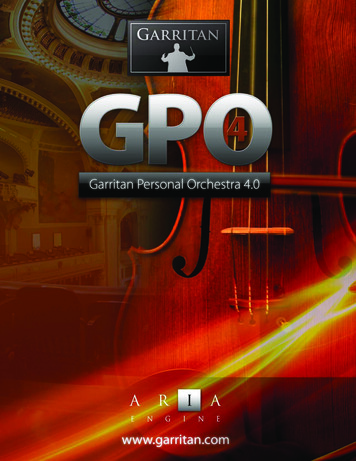
![Ewql Symphonic Orchestra Gold Full [PATCHED]](/img/66/talemm.jpg)
